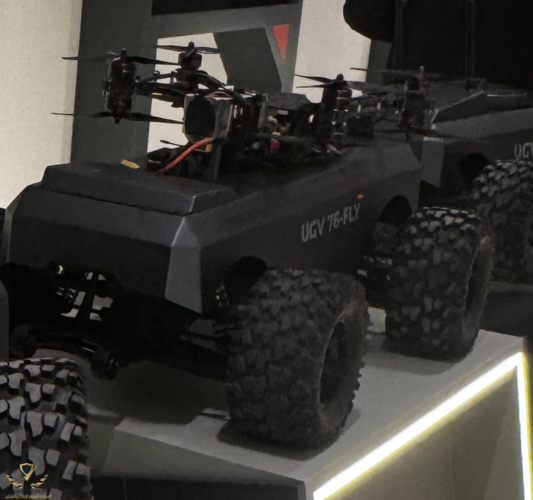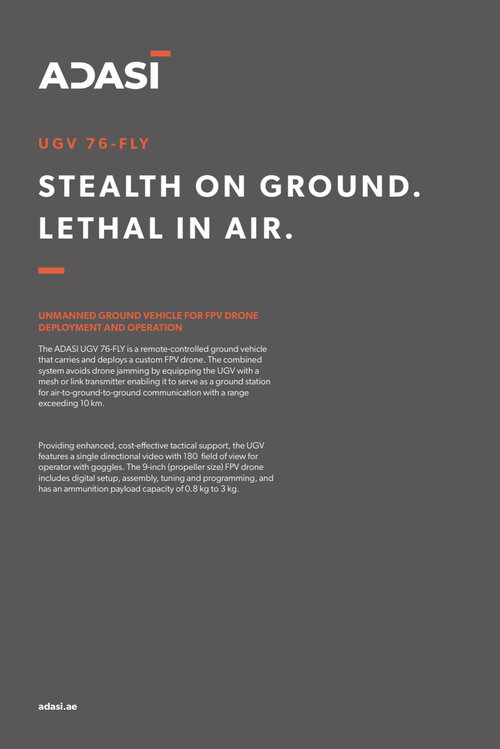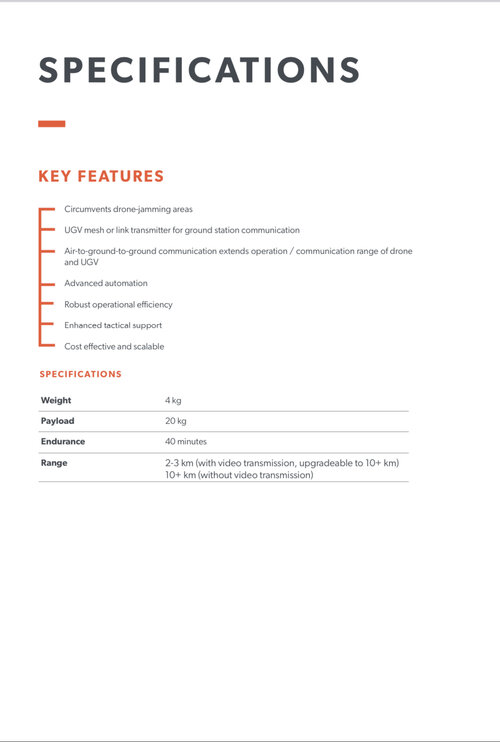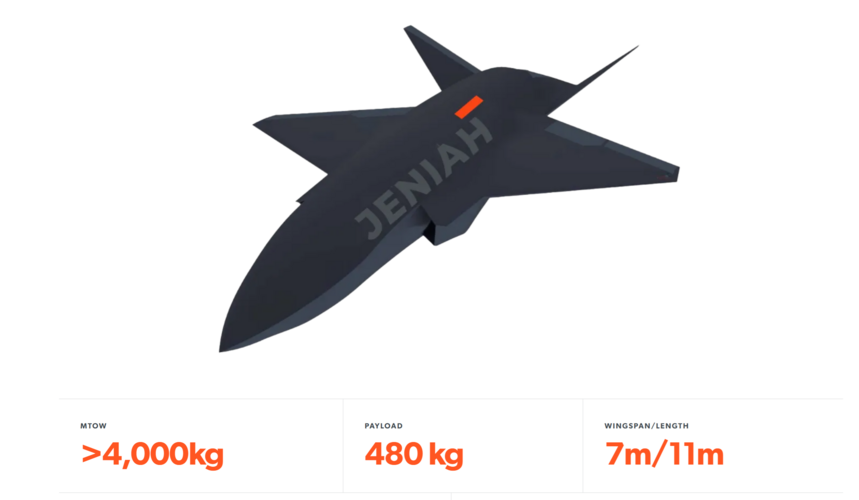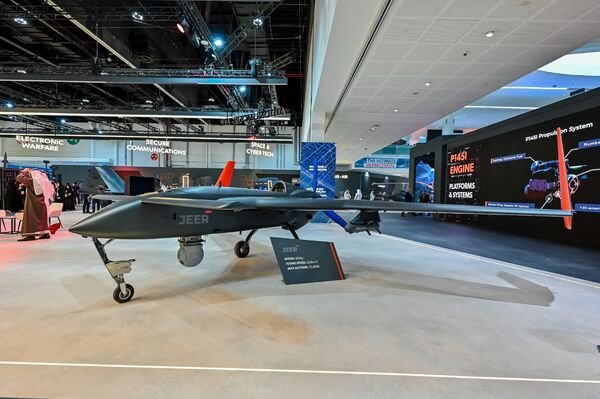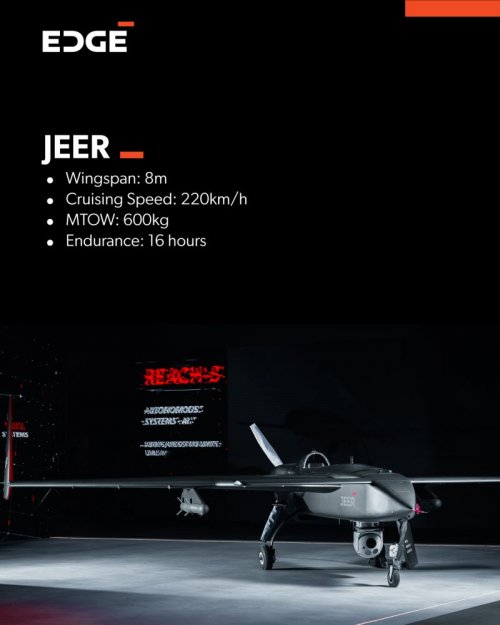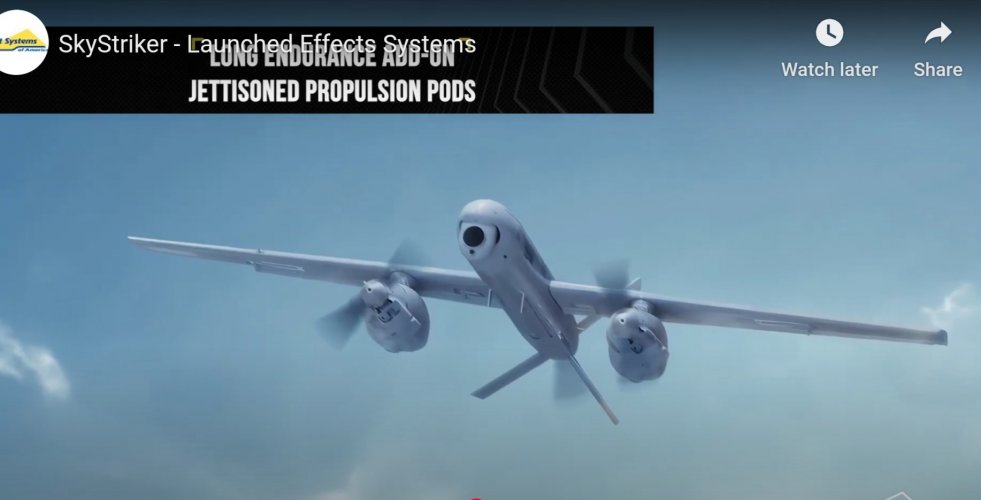You are using an out of date browser. It may not display this or other websites correctly.
You should upgrade or use an alternative browser.
You should upgrade or use an alternative browser.
Small UAS / Drones and related general thread - NOT Swarming ones.
- Thread starter Hanse
- Start date
Big_Zukini
ACCESS: Confidential
- Joined
- 23 November 2024
- Messages
- 163
- Reaction score
- 226
So:Single rotor is quieter and I believe more energy efficient. I think the multi rotor set ups are faster, easier to control, and are liable to have a rotor strike in confined quarters.
Speed:
Multi rotor.
Controllability/stability:
Multi rotor.
Endurance:
Single rotor.
Signature:
Single rotor.
Salad:
Both.
Did I get that right?
VishnuOsiris
ACCESS: Confidential
- Joined
- 1 December 2024
- Messages
- 100
- Reaction score
- 188
The consumer market needs this asap. A non-lethal one for people hiking or surveilling their property etc. Apple Football? Maybe an overhead Apple drone for the wedding photos?
VishnuOsiris
ACCESS: Confidential
- Joined
- 1 December 2024
- Messages
- 100
- Reaction score
- 188
For what it's worth, it my unsolicited opinion, I found the UGV's contribution to the latest battlefields as... "meh." It would appear dominating the terrain element still requires something like an Abrams or Bradley, just like the old days. I'm not sure what the UGV mothership provides you that is otherwise not provided by an FPV with greater range.
Last edited:
that’s true although if you fibre optic the UGV to the FPV you’d allow the operator to stay out of danger?!For what it's worth, it my unsolicited (and uneducated) opinion, I found the UGV's contribution to the latest battlefields as... "meh." It would appear dominating the terrain element still requires something like an Abrams or Bradley, just like the old days. I'm not sure what the UGV mothership provides you that is otherwise not provided by an FPV with greater range.
Forest Green
ACCESS: Above Top Secret
- Joined
- 11 June 2019
- Messages
- 9,473
- Reaction score
- 17,285

Ukrainian Long-Range Attack Drones To Be Tested By U.S. Military
Project Artemis will also evaluate American designs that could evolve into long-range kamikaze drones for the U.S. military.
DIU awards contracts for long-range, one-way drones; Ukrainian companies involved | InsideDefense.com
The Pentagon's innovation arm has selected four companies, two of which are partnered with Ukrainian firms, to receive contracts under its project to operationally evaluate long-range, one-way drones, the Defense Innovation Unit announced today.
Last edited:
kqcke for you
PUMA PUMA PUMA
- Joined
- 3 November 2022
- Messages
- 1,280
- Reaction score
- 1,689

UAVs auf hoher See – Jedes Schiff kann Drohnenträger sein
UAVs auf hoher See werden immer wichtiger zur Aufklärung. Mit einem System aus ISrael kann jedes Schiff ein Drohnenträger sein.
- Joined
- 23 August 2011
- Messages
- 1,608
- Reaction score
- 4,757
Scientific Question:
What are the pros and cons of multi-rotor and single-rotor designs?
I see all sorts of UAS for all sorts of endurance and payload categories and there doesn't seem to be a cutoff where one is preferable over the other. Big and small, these designs exist for all.
To simplify this, let's assume I need UAS for the following missions:
Every mission can have its own dedicated platform. What are my considerations for picking a single rotor or multi-rotor?
- Small radar, no platform speed requirements, long endurance.
- 1-2 ATGMs, no platform speed requirements, short endurance.
- 3-4 APKWS rockets, higher platform speed preferred, long endurance.
- 1-2 APKWS rockets, higher platform speed preferred, short endurance.
The choice isn't really single or multi-rotor...
It's IC or Electric, and VTOL or other launch method and winged or not.
1. Anything other than an IC engined fixed wing is pointless, something like a Tekever AR3, which already has a SAR payload and is in use in Ukraine. IC engine gives you power and endurance that batteries can't match at present...unless you want to go to something like the Zephyr for ultra long endurance at high altitudes.
2. A large Multirotor makes sense, Electric is possible due to short endurance
3. Given the weight and demand for long endurance you're back to a IC engine winged UAV, for the size of munitions you've basically just got yourself a Predator A...or if wanting something with VTOL the Strix.
4. You could use a large multi rotor copter for this, but why?
@kqcke for you : it won't work much at sea. For example, the fact that the UAS is pushed out of the island wind shielding is a major source of potential catastrophic failure, for the airframe and the ship.
At hook up, during landing, the probability of catching the cable are fairly low with the ship rolling and the wind blowing. Think that UAS would have to fly into the wind, crabbing, to have a linear trajectory, extending the cable sidewise, hence having to overfly the ship with all the risks of the cable being entangled in the ship structure.
(small vessels cannot always navigate into the wind in all sea states conditions)
Not a good idea.
At hook up, during landing, the probability of catching the cable are fairly low with the ship rolling and the wind blowing. Think that UAS would have to fly into the wind, crabbing, to have a linear trajectory, extending the cable sidewise, hence having to overfly the ship with all the risks of the cable being entangled in the ship structure.
(small vessels cannot always navigate into the wind in all sea states conditions)
Not a good idea.
Last edited:
shin_getter
ACCESS: Top Secret
- Joined
- 1 June 2019
- Messages
- 1,102
- Reaction score
- 1,482
Forest Green
ACCESS: Above Top Secret
- Joined
- 11 June 2019
- Messages
- 9,473
- Reaction score
- 17,285
Could target drones or helicopters.
VishnuOsiris
ACCESS: Confidential
- Joined
- 1 December 2024
- Messages
- 100
- Reaction score
- 188

French Navy experiments new unmanned systems to support amphibious operations - Naval News
The French Navy tested new technologies within amphibious operations to better adapt to threats faced in modern warfare.
The French Navy Chief of Staff commented the exercise as follow:
- “Adapting capabilities, training and organization, and adapting tactics to the threat. This is the aim of the DRAGOON FURY exercise, which ends tomorrow in the Mediterranean region. DRAGOON FURY is a force projection scenario in a restricted, coastal and contested air-sea area. DRAGOON FURY involves the joint integration of 700 soldiers from the French Navy and Army.
- Above all, DRAGOON FURY is a full-scale laboratory for testing all types of drones and drone systems, both defensive and offensive: surface, airborne and submarine drones. It’s the place for tactical innovation in all phases of maneuver:
- Before: intelligence, reconnaissance
- During: fire in depth, mine warfare, land force projection, air-combat from the Amphibious Helicopter Carrier
- After: support for ground troops, defense against multi-milieu multi-field attacks (cyber, informational, electronic warfare…)
VishnuOsiris
ACCESS: Confidential
- Joined
- 1 December 2024
- Messages
- 100
- Reaction score
- 188
Technology, drones and complexity: The IDF’s battle for Jabalya
Reporters' Notebook: This is my second time in Jabalya during the war against Hamas. It’s also the second time in the neighborhood with the IDF’s Multi-Dimensional Unit.
"Before units like the Multidimensional Unit brought new technology to the field, infantry and tanks would have to call in drone strikes, which takes time. They might investigate threats themselves and could run into ambushes."
"Using new precision technology, such as precision mortars called Iron Sting or the plethora of new drones that are arriving, gives units the ability to quickly close the circle in terms of timing, from seeing the enemy to confirming it to carrying out a precision strike."
"One terrorist who emerges with an AK-47 doesn’t need to be taken out with warplanes and artillery collapsing a house. A small precision weapon can get rid of the threat cheaper and faster."
shin_getter
ACCESS: Top Secret
- Joined
- 1 June 2019
- Messages
- 1,102
- Reaction score
- 1,482
There was an article about this on last night's six o'clock news and IMO it's a good idea that in addition making the Sherpas lives a bit easier will long term save lives too.
Forest Green
ACCESS: Above Top Secret
- Joined
- 11 June 2019
- Messages
- 9,473
- Reaction score
- 17,285
Forest Green
ACCESS: Above Top Secret
- Joined
- 11 June 2019
- Messages
- 9,473
- Reaction score
- 17,285
shin_getter
ACCESS: Top Secret
- Joined
- 1 June 2019
- Messages
- 1,102
- Reaction score
- 1,482

They set targets deep inside Russia on fire: the untold story of the 14th Unmanned Aerial Vehicle Regiment
For the first time, Ukrainska Pravda tells in detail the story of how the 14th Regiment was born – out of the audacity of a few officers who stumbled upon a drone in a warehouse, the willingness of senior military officials to take risks, and years of relentless work. Today, it is the only...
- Joined
- 23 August 2011
- Messages
- 1,608
- Reaction score
- 4,757
Its grand total of 4 rounds of 12guage , would have to be an extremely lucky shot on the pilot to do anything to helicopter
It's clearly aimed at intercepting fixed wing, like Zala, Supercam or Orlan.
SM2 from exported to Serbia from the UAE being tested that air burst is pretty effective imo for being 24 kg

From 1:54
View: https://m.youtube.com/watch?v=5d4c8kH-SnA

From 1:54
Received EOTS finally
Unfortunately I don’t know if bays are big enough to hold BVRAAMS
The P32 has a length of 2.4 meters but im not sure how much space is left inside of the bay.
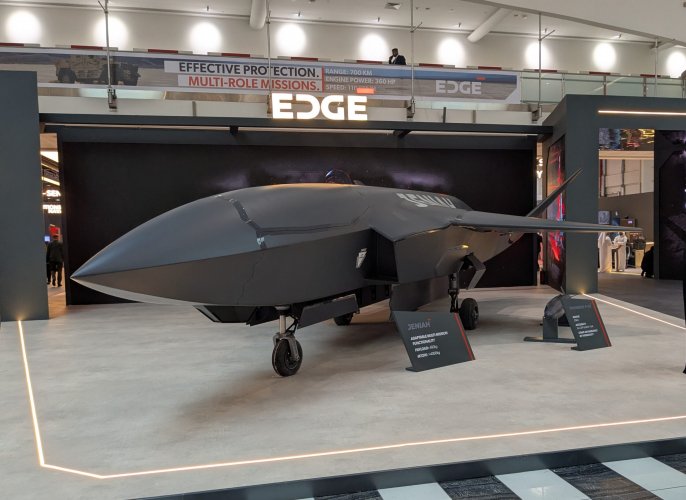
That bottom section is particularly interesting, would build up a lot of knowledge for a full fledged fighter if that’s the route the want to pursue.
This whole program will build up a lot of knowledge for larger aircraft eventually.
a joint GCC program would have the funds to develop a 6th gen program imo even if using many foreign components.
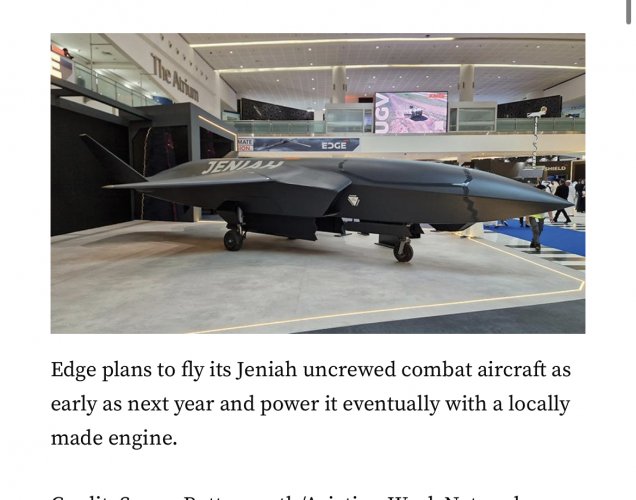
Last edited:
Received EOTS finally
Unfortunately I don’t know if bays are big enough to hold BVRAAMS
The P32 has a length of 2.4 meters but im not sure how much space is left inside of the bay.
View attachment 764335
That bottom section is particularly interesting, would build up a lot of knowledge for a full fledged fighter if that’s the route the want to pursue.
This whole program will build up a lot of knowledge for larger aircraft eventually.
a joint GCC program would have the funds to develop a 6th gen program imo even if using many foreign components.
View attachment 764336
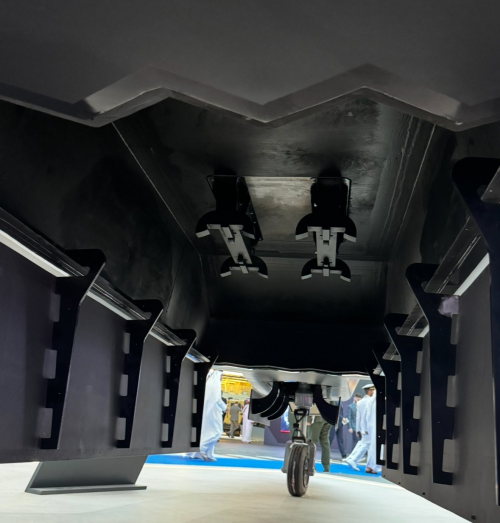
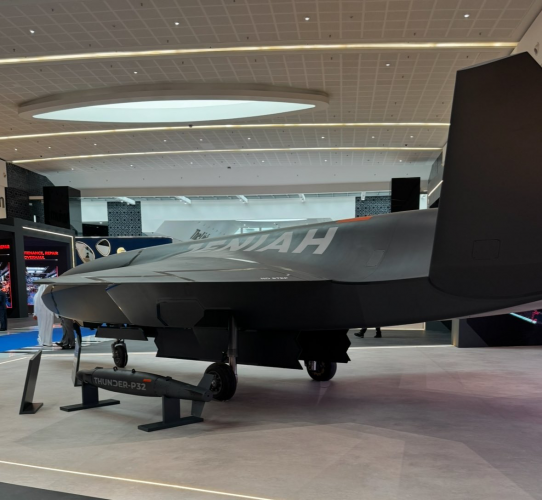
Any opinions on whether the bay extends longer than the length of the P-32 with is 2.4 meters? It looks to me like it does which would allow carrying of BVRAAMs.
Forest Green
ACCESS: Above Top Secret
- Joined
- 11 June 2019
- Messages
- 9,473
- Reaction score
- 17,285
Forest Green
ACCESS: Above Top Secret
- Joined
- 11 June 2019
- Messages
- 9,473
- Reaction score
- 17,285
Spiders be all confused and stuff. Birds be like, "sh*t the spiders are getting bigger man!"
VishnuOsiris
ACCESS: Confidential
- Joined
- 1 December 2024
- Messages
- 100
- Reaction score
- 188
Absolutely gorgeous.EDGE Jeer UCAV which should only cost 499k per which is quite cheap. UAE armed forces should receive 100 of these.
View attachment 765205
Forest Green
ACCESS: Above Top Secret
- Joined
- 11 June 2019
- Messages
- 9,473
- Reaction score
- 17,285
Also, apllicable to drones and how to kill them... or not.
View: https://x.com/NOELreports/status/1907097270580822130
View: https://www.youtube.com/watch?v=0M4fK7ycjEQ
View: https://x.com/NOELreports/status/1907097270580822130
Last edited:
aonestudio
I really should change my personal text
- Joined
- 11 March 2018
- Messages
- 2,964
- Reaction score
- 7,482
Last edited:
Forest Green
ACCESS: Above Top Secret
- Joined
- 11 June 2019
- Messages
- 9,473
- Reaction score
- 17,285

Germany says adding explosive drones to weapons arsenal
Berlin (AFP) April 4, 2025 - Germany said Friday it would buy explosive drones for the first time as Berlin boosts investments in its armed forces to counter the threat from Russia.
www.spacewar.com
Forest Green
ACCESS: Above Top Secret
- Joined
- 11 June 2019
- Messages
- 9,473
- Reaction score
- 17,285

MQ-35 V-BAT's Capabilities Grow, Micro Guided Munitions Coming Next Year
The combat-proven V-BAT can take off and land virtually anywhere and does the job of larger aircraft. Now it's getting a slew of major enhancements.

Every Marine A Drone Pilot: Individual Lethality To Go From Meters To Kilometers
First-person-view kamikaze drones and other precision munitions individual Marines can employ will make them much more than just riflemen.
Null
ACCESS: Confidential
- Joined
- 16 December 2024
- Messages
- 76
- Reaction score
- 109
In Simferopol, Russian developers showed a new high-speed FPV drone "Archangel" with a large range of up to 50 km. The developers optimized the aerodynamics, due to which, with the same batteries and motors, the drone moves much faster than its counterparts. Due to the different shape of the drone "Archangel", it was possible to achieve a flight speed of up to 280 kilometers per hour. Another key advantage of the drone is the versatility of its use. According to the developers, the drone can be launched from both ground platforms and carrier aircraft. The combat unit of the drone "Archangel" can weigh from 700 grams to 7 kilograms. The founder and head of the project Mikhail Filippov said that the test drones have already passed the first tests, in the future, the model awaits serial production.
The first footage of the launch of the Russian jet drone "Solist" has been published. It is a hybrid of a drone and a guided munition. The "Solist" complex is a disposable carrier with first-person control, like FPV drones. They are manufactured by the KEMZ concern, and the implementation is carried out by the ANO "Center Rivir". The launch is carried out from a transport and launch container. The drone allows you to attack targets and armored vehicles from above. You could say that this is an analogue of the American Javelin ATGM, only made as a drone. In the future, the Solist drone can replace mortars and ATGMs in the troops. The flight range of the Solist drone reaches 10 km, which exceeds the capabilities of most ATGMs. Ammunition from the RPG-7 and SPG-9, including cumulative, fragmentation and thermobaric charges, is used as a combat load. Serial production of drones will begin in mid-2025. The weight of the drone "Soloist" is up to 20 kg, the length is 1200 mm, the flight altitude is up to 2 km, the speed is up to 500 km/h. The price of the drone is unknown.
Last edited:
Similar threads
-
U.S. Transportation Secretary Announces Unmanned Aircraft Registration
- Started by Dragon029
- Replies: 9
-
-
Unmanned Long-endurance Tactical Reconnaissance Aircraft (ULTRA): USAF's semi-secret spy drone
- Started by Stargazer
- Replies: 0
-
-





